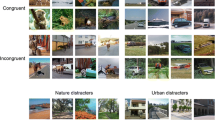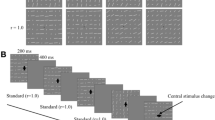Abstract
Pictured objects and scenes can be understood in a brief glimpse, but there is a debate about whether they are first encoded at the basic level (e.g., banana), as proposed by Rosch et al. (1976, Cognitive Psychology) , or at a superordinate level (e.g., fruit). The level at which we first categorize an object matters in everyday situations because it determines whether we approach, avoid, or ignore the object. In the present study, we limited stimulus duration in order to explore the earliest level of object understanding. Target objects were presented among five other pictures using RSVP at 80, 53, 27, or 13 ms/picture. On each trial, participants viewed or heard 1 of 28 superordinate names or a corresponding basic-level name of the target. The name appeared before or after the picture sequence. Detection (as d′) improved as duration increased but was significantly above chance in all conditions and for all durations. When the name was given before the sequence, d′ was higher for the basic than for the superordinate name, showing that specific advance information facilitated visual encoding. In the name-after group, performance on the two category levels did not differ significantly; this suggests that encoding had occurred at the basic level during presentation, allowing the superordinate category to be inferred. We interpret the results as being consistent with the claim that the basic level is usually the entry level for object perception.




Similar content being viewed by others
References
Brainard, D. H. (1997). The Psychophysics Toolbox. Spatial Vision, 10, 433–436.
Crowder, R. G. (1986). Auditory and temporal factors in the modality effect. Journal of Experimental Psychology. Learning, Memory, and Cognition, 12, 268–278. doi:10.1037/0278-7393.12.2.268
Evans, K. K., & Treisman, A. (2005). Perception of objects in natural scenes: Is it really attention free? Journal of Experimental Psychology: Human Perception and Performance, 31(6), 1476–1492. doi:10.1037/0096-1523.31.6.1476
Grill-Spector, K., & Kanwisher, N. (2005). Visual recognition: As soon as you know it is there, you know what it is. Psychological Science, 16(2), 152–160. doi:10.1111/j.0956-7976.2005.00796.x
Hautus, M. J. (1995). Corrections for extreme proportions and their biasing effects on estimated values of d′. Behavior Research Methods, Instruments, & Computers, 27(1), 46–51. doi:10.3758/BF03203619
Jolicoeur, P., Gluck, M. A., & Kosslyn, S. M. (1984). Pictures and names: Making the connection. Cognitive Psychology, 16(2), 243–275. doi:10.1016/0010-0285(84)90009-4
Macé, M. J.-M., Joubert, O. R., Nespoulous, J.-L., & Fabre-Thorpe, M. (2009). The time-course of visual categorizations: You spot the animal faster than the bird. PLoS ONE, 4(6), e5927. doi:10.1371/journal.pone.0005927
Mack, M. L., Gauthier, I., Sadr, J., & Palmeri, T. J. (2008). Object detection and basic-level categorization: Sometimes you know it is there before you know what it is. Psychonomic Bulletin & Review, 15(1), 28–35. doi:10.3758/PBR.15.1.28
Poncet, M., Reddy, L., & Fabre-Thorpe, M. (2012). Presentation time does not affect superordinate-level advantage in ultra-rapid categorization, poster presented at the 11th VSS conference. Florida: Naples.
Potter, M. C., & Faulconer, B. A. (1975). Time to understand pictures and words. Nature, 253, 437–438. doi:10.1038/253437a0
Potter, M. C., Wyble, B., Pandav, R., & Olejarczyk, J. (2010). Picture detection in rapid serial visual presentation: Features or identity? Journal of Experimental Psychology: Human Perception and Performance, 36(6), 1486–1494. doi:10.1037/a0018730
Potter, M. C., Wyble, B., Hagmann, C. E., & McCourt, E. S. (2014). Detecting meaning in RSVP at 13ms per picture. Attention, Perception, & Psychophysics, 76(2), 270–279. doi:10.3758/s13414-013-0605-z
Rogers, T. T., & Patterson, K. (2007). Object categorization: Reversals and explanations of the basic-level advantage. Journal of Experimental Psychology: General, 136, 451–469.
Rosch, E., Mervis, C. B., Gray, W. D., Johnson, D. M., & Boyes-Braem, P. (1976). Basic objects in natural categories. Cognitive Psychology, 8, 382–439. doi:10.1016/0010-0285(76)90013-X
Tanaka, J. W., & Taylor, M. (1991). Object categories and expertise: Is the basic level in the eye of the beholder? Cognitive Psychology, 23(3), 457–482. doi:10.1016/0010-0285(91)90016-H
Treisman, A. M., & Gelade, G. (1980). A feature-integration theory of attention. Cognitive Psychology, 12(1), 97–136. doi:10.1016/0010-0285(80)90005-5
Author Note
This research was supported by a National Institutes of Health Grant MH47432.
Author information
Authors and Affiliations
Corresponding author
Rights and permissions
About this article
Cite this article
Potter, M.C., Hagmann, C.E. Banana or fruit? Detection and recognition across categorical levels in RSVP. Psychon Bull Rev 22, 578–585 (2015). https://doi.org/10.3758/s13423-014-0692-4
Published:
Issue Date:
DOI: https://doi.org/10.3758/s13423-014-0692-4




